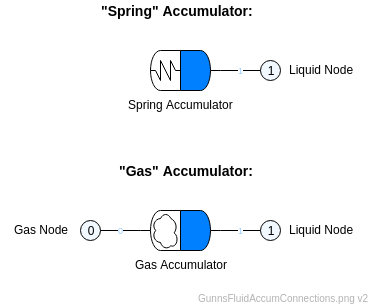GunnsFluidAccumGas - nasa/gunns GitHub Wiki

This extends GunnsFluidAccum to add the effect of gas pressurizing the liquid in the accumulator.
Most real-world accumulators are gas-charged, and most accumulator scenarios in GUNNS networks will involve gas pressure affecting the contained liquid somehow, so this link gets used more often than GunnsFluidAccum.
The gas that surrounds the liquid is represented by the gas node, replacing the Ground node from GunnsFluidAccum. The pressure of this gas is added to the bellows pressure on the liquid. Like with the bellows, the gas pressure has no effect on the liquid pressure when the bellows reaches completely empty or full.
The picture below shows how to connect accumulators in a network. The liquid and gas nodes can be connected to further liquid & gas plumbing via other links.

Port Connection Rules (These are limitations on the port connection to nodes that the link enforces in run-time):
- Port 0 (the cloud side) must always connect to a non-Ground node containing gas.
- Port 1 (the blue side) must always connect to a non-Ground node containing liquid.
Other Rules (These are extra rules you should always try to follow):
- Same as GunnsFluidAccum.
- Note that this link applies capacitance to the gas node and maintains the gas node contents itself, so no other capacitive links, tanks, accumulators, etc should be connected to it.
Configuration Data Parameters:
- maxConductivity: Same as GunnsFluidAccum.
- minConductivityScale: Same as GunnsFluidAccum.
- accumVolume: Same as GunnsFluidAccum. The minimum gas volume of the accumulator, when the bellows is at 100% full, is equal to this volume times the minChamberVolPercent, for simplicity. The actual gas volume then exchanges with liquid volume as the bellows position empties.
- minChamberVolPercent: Same as GunnsFluidAccum.
- minChamberVolDeadBandPercent: Same as GunnsFluidAccum.
- forceBellowsMaxRate: Same as GunnsFluidAccum.
- editHoldTime: Same as GunnsFluidAccum.
- minTemperature: Same as GunnsFluidAccum.
- maxTemperature: Same as GunnsFluidAccum.
- maxPressure: Same as GunnsFluidAccum.
- springCoeff0: Same as GunnsFluidAccum. Direct contact between the gas and liquid can be simulated by setting all of the spring coefficients to zero. This causes the liquid pressure to be equal to the gas pressure with no bellows in between. The gravity affect can be added to this if desired.
- springCoeff1: Same as GunnsFluidAccum.
- springCoeff2: Same as GunnsFluidAccum.
- gasMaxConductivity (default = 0 m2, must >= 0): Like the liquid maxConductivity in GunnsFluidAccum, this models the opening through which gas flows in and out of the accumulator's gas volume, just like a GunnsFluidConductor. A higher conductivity allows faster flow in and out of the accumulator, but too high a value can make the model unstable. You should tune this to correspond to the real orifice area -- see the GunnsFluidConductor notes on tuning.
- gasMinConductivity (default = 0 m2, must >= DBL_EPSILON): This sets a lower bound on the conductance of the gas opening. Like with the liquid side, the gas opening conductance drops as the bellows approaches a limit, to promote stability. However unlike the liquid side this is not completely shut off, turning the accumulator into a fixed non-zero volume tank on the gas side when the bellows becomes rigid at a limit. This term limits the conductance of the gas side opening and allows gas flows in & out of the gas volume.
- maxForcePressureRate (default = 0 kPa/s, must > 0, recommend < 30): This value limits the rate at which accumulator liquid pressure can ramp during the user's pressure edit. Combining too high a value here with a rapid pressure edit can cause model instability.
Input Data Parameters:
- malfBlockageFlag: Same as GunnsFluidAccum.
- malfBlockageValue: Same as GunnsFluidAccum.
- initialBellowsPosition: Same as GunnsFluidAccum.
- liquidFluidInputData: Same as GunnsFluidAccum.
- gasFluidInputData (default = NULL, must != NULL): This defines the initial fluid state of the gas in the accumulator's gas volume. Similar to initialFluidState in GunnsFluidCapacitor.
- Same as GunnsFluidAccum.
- N/A